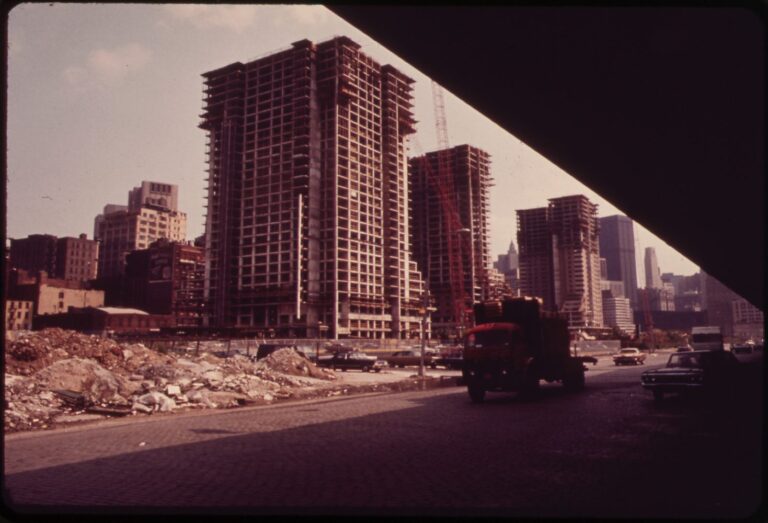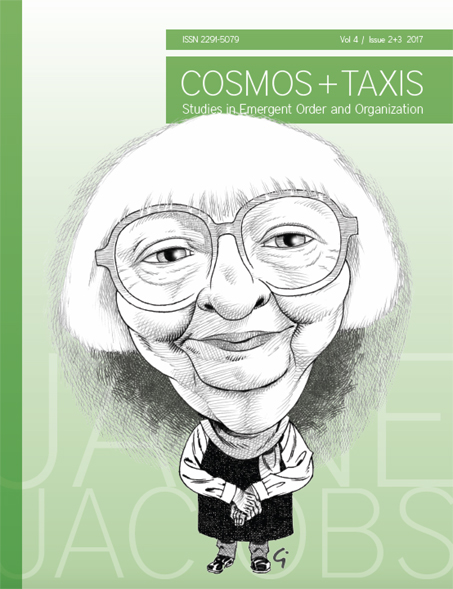Physical Address
304 North Cardinal St.
Dorchester Center, MA 02124
Physical Address
304 North Cardinal St.
Dorchester Center, MA 02124
Land-use scholars have offered a variety of policy proposals that attempt to identify institutional reforms to reduce the incentive for homeowner NIMBYs to protest development. For example, in a 2013 paper law professor David Schleicher proposed a policy called Tax Increment Local Transfers (TILTs). When a municipality permits a new development, the new construction will increase its tax base by an amount called the tax increment. Schleicher suggests that the tax increment could be transferred to NIMBY homeowners to buy their support for new housing. But homeowners aren’t the only vocal opponents to new housing. Anti-displacement activists are also prominent opponents to new construction. What if we also dedicated TILT revenues to anti-displacement causes? Making new housing construction feasible in the cities with the best job opportunities is of serious importance for economic opportunity and mobility. Research by Peter Ganong and Daniel Shoag (covered here by Sandy and me and here by Matt Yglesias) demonstrates that restricted housing supply in the U.S.’s most productive cities has resulted in less income mobility over the past 40 years. Ganong and Shoag explain that during the high-mobility period of 1940 to 1960, people moved from low-income to high-income states. In the process, the labor forces in high-income states grew, putting downward pressure on their wages relative to low-income states. As income increased across all states during this time period, it grew fastest in the lowest-income states. Ganong and Shoag show that the negative relationship between income growth rates and average income across states has broken down since 1980 with the rise of land-use regulations that have severely limited housing supply growth in the country’s most productive cities. Specifically, they find that if income convergence had continued at its 1940-1960 rate through 2010, hourly wage inequality would be eight percent lower today. While homevoters are responsible for the lion’s […]
Ever since zoning was invented in the 1920s, homeowners have argued that limits on density and on multifamily housing are necessary to protect property values. But today, urban NIMBYs seek to prevent new housing on the ground that new housing will lead to gentrification, which will in turn lead to increased property values, which in turn will lead to rising rents and displacement. Similarly, I often read that cities and suburbs shouldn’t have any new housing because they might become “too dense” or “overcrowded.” (Never mind that when there’s not enough housing to go around, excluded residents respond not by leaving the city, but by sleeping on the streets, thus making the city feel even more crowded). But at the same time, I also read that building new housing is futile, because it will all be bought up by foreign oligarchs, who (because they aren’t quite greedy enough to rent out their property) cause the housing to be lifeless and unoccupied. It is not quite clear to me how the city can be overcrowded and undercrowded at the same time, but evidently this view seems to be common.

You wake up thirty minutes before your alarm, jerking up after having a nightmare about a car crash. Reluctantly, you clean up, eat breakfast, and hop into your car. Work is only three mile away—easy biking distance—and there are 15 or so people in your neighborhood who work where you work—enough for a commuter bus make sense. But alas, the city required the developer to provide two parking spaces for your townhouse and the cost is hidden somewhere in your mortgage, so why not use it? After spending thirty minutes traveling three miles on the freeway—at least we live in the Golden Age of Podcasting, right?—you arrive at your suburban office park and pull into the garage. The parking is “free,” meaning that your pay has already been docked to cover the cost of the space, so why not use it? Your girlfriend calls shortly after lunch, asking if you want to go on a double dinner date with her friends to a new BBQ place downtown. You agree to join. You’re starving—you left lunch at home and it’s just too time consuming to drive to a decent place—so you hustle downtown. You arrive first, only to find out that there is only on-street parking. Downtown is, after all, exempt from parking requirements, and since street parking is “free,” it’s impossible to find a space during dinner time. You call your dinner partners—each of them is driving separately from work—and suggest another BBQ place downtown that offers subsidized garage parking. This place is a little more expensive, since the restaurateur has to cover some of the cost of offering parking, but you’re all hungry and don’t want to deal with the headache of cruising for street parking. Eventually you all meet and enjoy a nice meal, speculating about how traffic […]

During his last days in office, former Representative Jason Chaffetz must have forgotten he is supposed to be a fiscal conservative. His recent comments that members of Congress need $2,500 stipends to afford housing in DC reflect a complete ignorance of both the reasons for high housing prices and the best ways to lower those prices. Instead of treating the symptoms of skyrocketing housing prices, policymakers should be striking at the root: rent control, height limits, and burdensome zoning restrictions that discourage development. All of this turns on basic economics. Markets drive prices of goods and services down, but only if they are competitive. In many cases, existing interests try to prevent others from entering markets in order to protect their own bottom lines. Zoning regulations are often manipulated by interest groups, who hope to limit the allowed uses of land within a city and prevent future developments. Zoning essentially fixes the amount of available housing by discouraging developers from building more housing, ultimately driving housing prices up. Academic research places much of the blame for high housing costs on zoning––and this isn’t just limited to a single city or state. Edward Glaeser and Raven Saks of Harvard and Joseph Gyourko of the University of Pennsylvania examined Manhattan’s housing market estimate that new construction costs for housing are only about $300 per square foot, but that square foot tends to be rented out for $600, twice the cost at construction. Glaeser, Gyourko, and Saks write, quite intuitively, that “this would seem to offer an irresistible opportunity for developers.” But it’s zoning regulations that prevent developers from coming in to build more homes (which ultimately lowers housing prices), despite market incentives. Even though there is a deafening clamor for more housing, as evidenced by rising prices, building takes so long in […]

In a recent blog post, Julia Galef has generated a fairly comprehensive list of pro-housing arguments and counterarguments to those arguments. She gives the most detailed consideration to the “infinite demand” argument- in her words, “So even if SF adds a lot of additional housing, prices will still rise almost as quickly as they would have anyway, as long as demand to live here continues to soar. This view is mainly based on examples of other desirable cities, like New York or Singapore, which have built new housing at a faster rate than SF but nevertheless saw steep increases in price.” To which I respond: New York? Really? New York is only pro-housing when compared to San Francisco- which is a bit like saying Iran is a libertarian paradise compared to the Islamic State. In fact, New York has built housing at a glacial pace. Between 1960 and 1976, the number of new housing units completed per year ranged from just over 14,000 to over 60,000, and exceeded 20,000 in all but four years. In the almost forty years since 1976, the number of new units exceeded 20,000 in only four years (2006-10) and was above 14,000 for only ten years (1989, 2002, 2004-10, 2015). Meanwhile, demand for housing has increased: between 2006 and 2014 alone, the citywide renter population grew by 600,000. A better example of a “desirable city” would be a city where both the population and the housing supply is growing at a rapid rate- Raleigh, for example, or Las Vegas. These cities are much cheaper than New York or San Francisco.* Another example of a cheap, permissive city is Tokyo. But the post suggests Tokyo may not have grown as fast as American cities. In fact, Tokyo’s regional population grew by 17 percent since 1990- from 32.5 million […]
I recently saw a Facebook post asserting that San Francisco has 30,000 vacant units, so therefore no market-rate housing should be built. So I looked up Census data on these allegedly empty units. It is true, according to the Census Factfinder website, that there are 30,000 or so unoccupied housing units in San Francisco. Does this mean that they are completely idle? In fact, no. More than half of these units were (as of the 2010 Census) currently for sale or for rent. 18 percent for for seasonal use (presumably, second homes). Only 5 percent are rented or sold but unoccupied. The rest are “other vacant”. whatever that means. Bottom line: half the vacancies were in the process of being sold or rented. A little under a fifth were second homes. About a third we don’t know much about.
Richard Rothstein’s “The Color of Law: A Forgotten History of How Our Government Segregated America” should be required reading for YIMBYs and urbanists of any ideological stripe. Rothstein argues that housing segregation in the US has been the intentional outcome of policy decisions made at every level of government and that the idea of segregation as phenomenon driven by spontaneous self-sorting is largely a myth. Two major themes permeate the book: (1) the ways in which government has consistently intervened in the housing and land markets and (2) how these interventions were designed to pick winners and losers. The federal policy of underwriting loans for specific kinds of development (single family detached housing) and for specific people (whites) is an example that the author explores in depth. And after reading his account, I can safely say that I have a far better understanding of how nearly a century’s worth of policy interference has distorted markets and doled out privilege and oppression in equal measure. Throughout the book, Rothstein brings in the stories of specific people and places to add depth to his account. This both keeps things interesting and serves to humanize the story in a way that many tracts on policy fail to do. When he’s describing the lives of black Americans who were forced into soul crushing commutes because they were legally prohibited from living near their jobs, or families who had their houses firebombed for daring to move into a segregated neighborhood while police stood on their front lawns and watched…you remember that policy matters because it affects real people. And that real people suffered terrible wrongs for no other reason than the accident of their birth. Again, if you care about US housing policy, you must read this book. It’s impossible to understand where we are […]
Some people accept the idea that restrictive land use policy is just as bad as all the research suggests, but persist in supporting the status quo. They argue that if a community chooses to regulate its built environment, that choice should be respected as having moral weight because it’s the outcome of a democratic process. This argument, though, is as logically confused as it is normatively problematic. And in the following few lines, I intend to demonstrate exactly why. No decision making process is value neutral. Whatever way we choose to go about collective decision making, we will always privilege certain voices over others. Institutions beget outcomes and the internal logic of our institutions will always favor some outcomes (and therefore voices) over others. The same individuals with the same preferences asked to make the same decisions through different procedures will produce wildly different outcomes. Imagine a U.S. Presidential election based on the popular vote or representation in the U.S. Senate proportional to state population and you should begin to see how the public will is as much a product of procedure as it is aggregated individual preference. Taking the Bay Area as a land use specific example, our system heavily favors the voices of incumbent homeowners to the detriment of everyone else. Land use decisions take place at the municipal level which–given the fact that we have 101 different municipalities–is a hyper local affair. When a new development is proposed, it only takes a handful of angry neighbors to impact decision making. Were land use set at a higher level of government, the typical number of people that get angry over an individual project would be far less effective at killing new housing. Fifty angry homeowners might matter to the Palo Alto City Council, but they’d be quite a […]
Market Urbanism may soon have a hearing in the Supreme Court. Two of my colleagues at the Mercatus Center, Sandy Ikeda, half a dozen other professors, and I argue that the Court should take up the case 616 Croft Ave., LLC, v. City of West Hollywood. The case is an opportunity for the Court to determine whether inclusionary zoning violates its standards for legal exactions from developers. Inclusionary zoning requires developers to rent or sell some units in new projects at below-market prices. The Court has established that local governments can only require benefits from developers when these benefits offset a public nuisance from the project. Inclusionary zoning fails this test. The facts of the case could have played out in many American cities. Real estate developers Shelah and Jonathan Lehrer-Graiwer purchased two single family homes that they replaced with 11 condo units. West Hollywood’s inclusionary zoning rule required them to either make 20 percent of the units in their new project available at below-market prices or to contribute $540,000 to the city’s affordable housing fund. The Pacific Legal Foundation is representing the Lehrer-Graiwers suit. They have petitioned the Supreme Court to review earlier decisions from California courts that upheld West Hollywood’s policy. West Hollywood’s inclusionary zoning policy states that its purpose is to “off-set development impacts” that new housing construction causes. This justification is based on the false assumption that new housing development raises housing prices by replacing older, cheaper housing with newer, more expensive housing. This fallacy may seem reasonable at first glance. New construction is often more expensive than the older homes it replaces. But as these once-new houses age, they become affordable to lower-income residents. New construction is the only way to increase housing supply, and new units have the potential to become market-rate affordable housing over time. Housing economists call this process “filtering.” One estimate puts the […]

Jane Jacobs’ writings span several disciplines—including ethics and most especially economics—but she is best known for her contributions to and her critique of urban planning, design, and policy. Many of those whom she influenced in academia, policy, and activism took the occasion of her one-hundredth birthday in 2016 to celebrate those contributions through lectures, biographies, and various events and publications. The current issue of COSMOS + TAXIS is offered in that same spirit. I am especially pleased that it includes the contributions of a diversity of scholars—with backgrounds in economics, urban policy, urban planning, geography, architectural history, and engineering—with a diversity of insights expressed from the perspectives of epistemology, intellectual history, spatial analysis, urban history, private cities, mercantilism, and of course spontaneous order; and ranging in approach from the theoretical to the historical to the applied. Indeed, we learn from Jacobs that from the diversity of the living city springs experiment, creativity, and surprise; and that pertains equally to the realm of living ideas. Read these pages and be surprised! Articles Special Issue on Jane Jacobs [pdf] Sanford Ikeda Jane Jacobs as Spontaneous Economic Order Methodologist: Part 1: Intellectual Apprenticeship [pdf] Pierre Desrochers and Joanna Szurmak Jane Jacobs as Spontaneous Economic Order Methodologist: Part 2: Metaphors and Methods [pdf] Joanna Szurmak and Pierre Desrochers Experimenting in Urban Self-organization: Framework-rules and emerging orders in Oosterwold [pdf] Stefano Cozzolino, Edwin Buitelaar, Stefano Moroni, and Niels Sorel Modern Cities as Spontaneous Orders [pdf] Wendell Cox and Peter Gordon NIMBYs as Mercantilists [pdf] Emily Hamilton A City Cannot be a Work of Art [pdf] Sanford Ikeda The State of Indian Cities [pdf] Shruti Rajagopalan The Kind of Problem Gentrification Is: The Case of New York [pdf] Francis Morrone Reviews The Accidental City: Improvising New Orleans by Lawrence N. Powell[pdf] Leslie Marsh